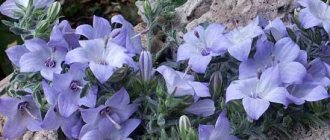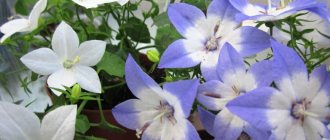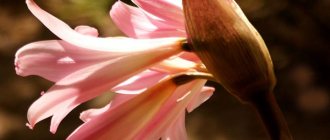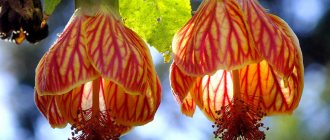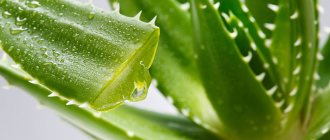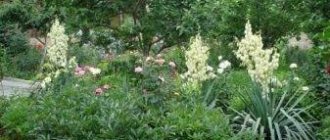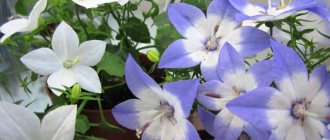- November 1, 2018
- Houseplants
- Nastasya Krakhina
Among flower growers, the campanula flower, which is popularly known as “bride,” is very popular. The plant received such an affectionate nickname due to its appearance - when the delicate flowers bloom, they look like an incredibly beautiful bride’s outfit. There is even a sign that says that if you give this flower to newlyweds for their wedding, their home will be filled with joy and love.
This article will tell you in detail about the features of caring for the “bride” flower at home. The following will describe the rules for watering, planting, selecting temperature, humidity and lighting for favorable plant growth.
Detailed description of the Campanula (“bride”) flower
This indoor plant is a herbaceous plant. It has hanging, creeping shoots. The plant is covered with a large number of flowers that are shaped like a star. Campanula may have white, blue or purple flowers. It is often found that a plant with white flowers is combined with blue ones in the same pot. This gave rise to calling this arrangement of indoor flowers “bride and groom.”
The leaves of the plant are on thin and long petioles. Flowers can reach 3-4 centimeters in diameter. Campanula flower is a perennial plant. If the plant is provided with proper care, it will delight household members with abundant flowering for a very long time.
The intensive flowering period of the “bride” begins in June and ends in October. According to the advice of experienced flower growers, in order for the plant to be especially beautiful during this period and bloom for as long as possible, it is necessary to promptly remove those buds that have begun to dry out.
Home maple abutilone
This home plant is appreciated by flower growers for its long and bright flowering, because with proper care it will produce new buds until the cold autumn. It is a guest in our latitudes; its natural habitat is in the subtropics: Africa, Asia and Australia. The question naturally arises whether abutilone is poisonous or not, because many plants from hot countries contain toxic or dangerous substances in their tissues. But homemade maple is not only completely safe, but is also considered a medicinal plant in its homeland.
Which species are suitable for home cultivation?
Flower growers recommend planting two types of campanula at home - equal-leaved and brittle bell. These are the most unpretentious species that do not require too much attention.
However, if you want to plant Campanula as a couple - “bride and groom”, then you should adhere to the following varietal scheme:
- Alba ("bride") and Maya ("groom"). Alba is the oldest and most proven variety that has been grown at home for more than 50 years. Its abundant bloom of white flowers pleases the eye. Maya has blue flowers, velvet stems and leaves. This pair of varieties goes well together.
- Atlanta ("bride") and Napoli ("groom"). These two varieties are representatives of modern selection. The white “bride” Campanula Atlanta, unlike its ancestors, is more compact, and its flowering is abundant. The Napoli variety has bright blue flowers, and the bush is more branched. Today, Napoli is considered a noble variety of domestic plants.
- Dublin white (“bride”) and Dublin blue (“groom”). These varieties are distinguished by the fact that they have double flowers and abundant flowering.
- White portenschlag (“bride”) and blue portenschlag (“groom”). Such indoor flowers “bride and groom” of these varieties are distinguished by the fact that they have small spherical flowers. In addition, these two varieties bloom continuously.
- Dublin white 2 (“bride”) and cirillo (“groom”). “Bride” is an improved version of the Dublin white variety. It also has double flowers. In general, the plant is very compact and blooms with a beautiful cap. And the Cirillo variety is rare and very unusual. It has blue flowers with a darkened center. Rosettes form on the tendrils-shoots, which provides a lush cascade of flowers. The variety is named after the famous botanist from Italy Domenico Cirillo.
Abutilone - types
In order not to make a mistake and choose the right type of home maple for indoor use, you should look among the varieties suitable for such purposes. They all have common characteristics.
- The size of an adult bush will not clutter up the entire area.
- The bush always has many branches, which makes it elegant and lush.
- Abundant flowering and variety of shades. The flowers are large, and the foliage pleases the eye with its brightness and variegated patterns.
- Almost all varieties of abutilon for home cultivation can bloom for a very long time, without requiring additional illumination with lamps.
Abutilon Megapotamian
You can grow an ampelous or semi-ampelus bush from this type of domestic maple. However, there are some difficulties in growing.
- In their natural growing environment, shoots can easily reach 2.5 m. The florist will have to deal with such rapid growth of shoots in apartment conditions.
- Indoor maple abutilon cannot be formed at will. It is difficult to form a bush.
- Another difficulty is that it is not always possible to achieve flowering. If this succeeds, the bush will be covered with drooping, spectacular branches with yellow petals and bright red-violet stamens.
- This type of abutilon needs abundant watering and does not tolerate constant exposure to direct sunlight. Every two weeks, mineral fertilizers are applied to the soil - nitrogen, phosphorus, potassium. Every spring, it is advisable to remove the bush from the old soil and replant it in new nutritious soil.
Abutilon Bella
A distinctive feature of this species is the compactness of the bush and the enviable density of the crown. Flowering will be abundant and bright. Lush greenery is represented by small leaves, which become the background for large pink or red flowers. Indoor abutilon of this variety series is suitable for a compact indoor garden, because the crown dimensions rarely exceed 40 cm in height.
Abutilone Hybrid
The leaves of this species are more similar to maple than others. The length of the leaf blade can reach 12 cm; together with the bark, they are covered with a light coating of wax. The bell is approximately 5 cm in diameter and blooms in orange, yellow or burgundy.
- The abutilon needs to be replanted annually, but the pot should not be too large. The peculiarity of this species is that flowering will occur after the roots have completely entwined the earthen coma.
- In the spring and until the beginning of autumn, you will have to feed your home maple bush weekly.
- Hybrid abutilon grows up to two meters. Therefore, every spring it is cut to half the length of the shoot. Crown density and splendor are achieved by pinching. Abutilon flower of this type is considered unpretentious.
- In winter it should be placed on the brightest windowsill, and in summer it should be placed on the balcony in partial shade.
Abutilon Juliet
Abutilon Juliet's calling card is considered to be constant, continuous flowering. If you provide proper lighting, the abutilon plant blooms almost all year round.
- The bush grows at an enviable speed and branches well. But every year you will have to trim the shoots, because without this procedure they grow up to one and a half meters.
- The flowers are bell-shaped and reach 6 cm in diameter. There are many shades of flowering.
- The peculiarity of the species is its ability to retain all varietal characteristics even during seed propagation.
Abutilon Variegated
The species is suitable for compact growing or forming a tree. Depending on pruning and the method of crown formation, the height of the bush varies between 50-150 cm. Feature in foliage: according to the description, variegated abutilon is covered with emerald green leaves with an edge. With sufficient lighting, bright yellow and white spots appear on the leaf plate; in constant shade, they are replaced by a light green color. Flowering may be yellow or red-orange.
Flower bride: care at home, features
As noted earlier, caring for this plant is very simple and does not require excessive effort on the part of the grower. You can grow campanula from seeds, and the most important thing during this period is to provide the plant with good lighting and watering.
At the time of planting, it is necessary to take into account that the plant has hanging shoots. Therefore, the best option is to plant it in hanging pots (plant pots).
Of course, like all plants, campanula requires compliance with the rules of watering, fertilizing, selection of lighting and humidity when caring for it. It's worth taking a closer look at them.
What to do with the tree of love after the wedding?
Of course, you shouldn’t deprive your tree of attention after planting. If it was planted in the city, of course, it will be taken care of even without the newlyweds. But it’s worth visiting him - who knows, maybe the words about energy are true? If the tree was planted in the forest, it is worth visiting periodically to monitor its fate. Naturally, a tree in your own yard or garden needs to be constantly looked after - and then it will give the young family flowers in the spring and fruits in the summer. However, even a non-fruit tree will delight you with its appearance. And the whole family can decorate the same Christmas tree for the New Year.
Planting the Tree of Love is not just a beautiful “one-time” tradition. It is believed that a family plant reacts very sensitively to spouses, and if there are quarrels in the family, it dries out and gets sick. So the most important thing is to grow feelings for each other and enjoy every day spent together.
Watering
The Campanula flower adapts perfectly to water of any hardness. However, it is best to use regular tap water, which has been left to sit for several days. In the warm season, watering becomes more frequent, and in the cold season it is done less frequently.
You can determine a flower's need for water by testing the soil; it should be slightly moist. This is key when maintaining a flower bride. Care at home requires that there is no stagnation of water in the pot.
Diseases and pests
If the campanula is not watered correctly or does not provide it with suitable conditions for growth, this can cause the development of a fungal disease. In order to cure a flower, cut off all affected stems and foliage, then spray the plant and the surface of the substrate in the pot with a fungicide.
If the air humidity in the room is extremely low, then a spider mite or scale insect may settle on the flower. Such insects are sucking, and they feed on the cellular sap of the flower. If ticks settle on the bush, it should be treated with an acaricide, for example: Actellik, Fitoverm or Aktara. It is not so easy to deal with scale insects, since they are protected by a chitinous shell and covered with wax on top. First, scale insects should be removed from the bush with a very hard brush, and then it should be sprayed with acaricide. If the bush is severely affected by a fungal disease or there are a lot of pests on it, then it should be treated several times with an interval of 1–1.5 weeks.
On an absolutely healthy bush, leaf plates may begin to turn yellow. This is usually due to prolonged exposure to direct sunlight. Strongly elongated shoots indicate excessively poor lighting.
Top dressing
Campanula, like all other plants, periodically needs feeding. This is due to the fact that the soil in pots gradually releases all the nutrients to the plant and becomes neutral.
Mineral and organic fertilizers will help ensure a healthy plant. Feeding should be done in small quantities once a month. Flower growers note that the best fertilizer for campanula is a solution of the Kemira-Lux preparation.
During the period of abundant growth, you can feed the young plant once every ten days. This is also one of the key points when maintaining a “bride” flower. Home care requires that the plant always has enough nutrients.
Which tree to choose as the Tree of Love
Which Tree of Love to plant at a wedding depends on the choice of the newlyweds themselves. It is believed that the best family tree is a fruit tree: pear, apple, cherry, sweet cherry... Fruits represent a growing family. However, there is one “but” - fruit trees, alas, live less than others. If newlyweds want their tree to live for a long, long time, they should choose walnut, oak, or spruce.
It is believed that apple, oak and birch trees have very good energy. You can always turn to these trees for help in difficult times. If you lean against their trunk, you can feel a surge of vital energy.
Among domestic trees, lemon is considered optimal - it feels great in the house and bears fruit. But other options are also possible.
Air
For good growth and health, it is necessary to provide the correct air for the campanula. At home, care requires observing the temperature regime and maintaining the required level of humidity. In summer, the optimal temperature for the “bride” will be up to +25 °C, and in winter – about +12 °C. The plant loves to breathe fresh air, so placing it on a balcony or terrace from spring to autumn is considered an excellent option.
Campanula loves moderate humidity, but absolutely does not tolerate drought. Therefore, you should spray the leaves with a small amount of water in the warm season.
Reproduction methods
To propagate indoor campanula, the seed method is used, as well as cuttings, dividing the bush and planting young shoots. At the same time, vegetative methods are more popular among gardeners, since they are simpler and more effective compared to seed methods.
Cuttings
To cut cuttings, use the lower parts of the shoots remaining after pruning. For rooting, they are planted in a substrate of sand and peat, which is spilled with Fitosporin, and they are covered with a transparent dome on top. At temperatures from 20 to 25 degrees, the cuttings take root quite quickly. During rooting, the cuttings are not watered; they are only systematically moistened with a sprayer. After the cuttings reach a height of about 10 centimeters, pinch their tops to make the bushes more lush.
Reproduction by young shoots
After young shoots grow on the bush in spring, separate several pieces along with the heels. Plant the shoots for rooting in the same substrate as the cuttings, and also cover them with a transparent cap. For rooting to be successful, the shoots must be kept cool (about 12 degrees). The roots on the shoots should grow in 20–30 days; immediately after young foliage appears on the plants, remove the shelter and move them to a warm, well-lit place (the light should be diffused).
Dividing the bush
A heavily overgrown bush can be divided into parts during transplantation. Treat the cut areas with charcoal powder. After this, the divisions are planted in separate containers. The planted cuttings are well watered and protected from direct sun rays for the first days.
Growing from seeds
Seeds are sown in early spring. For sowing, use a bowl, which is filled with seedling soil mixture. Bell seeds are very small, they are evenly distributed over the surface of the substrate and covered with a thin layer of earth on top. The crops are moistened very carefully using a sprayer. The emerging seedlings also need to be watered using a spray bottle. They are picked into individual cups after they have formed 3 true leaf plates.
Magical properties of myrtle: signs and superstitions
Since myrtle is primarily associated with love and marriage, as well as the goddess of love (see the section "What does myrtle symbolize"), it is considered a feminine plant, and most superstitions and omens associated with myrtle, as well as its magical beneficial properties, are based on this.
- Myrtle jewelry attracts sincere, faithful love to its wearer. Also, myrtle jewelry helps maintain presence of mind and strong will, so they are given to shy, timid girls so that they show character.
- If you carve your name on a piece of myrtle and give it to your beloved man, his feelings will become stronger.
- Myrtle helps maintain beauty, strength, health and youth.
- A fragrant sachet using myrtle is placed in the bedroom to improve marital relations in bed.
- Since once a sprig of myrtle brought people news of the end of the Flood, myrtle to this day can signal both bad and good. For example, it is believed that if a plant blooms, if it is healthy and makes you happy with its bright greenery, it means that everything is calm and prosperous in the life of your family. But if the myrtle withers, gets sick, doesn’t bloom, pests appear, it drops its leaves - it means trouble is coming to one of the household members.
- The energy of the plant is purely positive, warm, it makes the atmosphere in the house calmer, more joyful, improves health, improves intuition and even promotes the conception of a child. You could say he has a healing aura.
- Please note that the myrtle tree loves to be looked after, taken care of, given words of gratitude and compliments, and told about the successes of the household.
But if you scold the myrtle, do not take care of it, and do not comply with the growing conditions, then it will wither. It will not harm, after all, it is an absolutely “positive” plant, but it will lose its medicinal properties. It is even believed that myrtle is capricious when choosing a pot and can wither if the pot is ugly. Therefore, if your myrtle suddenly, for no reason at all, begins to wither and wither, perhaps you should transplant it into another pot - it might help.
Even if you don’t believe in the magical properties of the plant, myrtle really pleases with its bright greenery, it has very beautiful flowering and an absolutely positive meaning, therefore, from a purely material, psychological point of view, the myrtle tree is really capable of pleasing and calming.
Pruning and crown formation
It sounds intimidating, but in fact, shaping myrtle is easier than it seems: it is a very flexible shrub. It is enough to simply trim with scissors or pluck leaves that, as you think, disturb the appearance of the plant and make it untidy and unattractive.
Don't be afraid of pruning: it only stimulates more intensive growth of a denser crown.
When is the best time to prune: after flowering, best in mid-spring.
Myrtle bonsai
Formally, this is, of course, not a bonsai. A bonsai is a tree that was supposed to grow large (pine, oak, ash...), but was grown in a certain way, essentially with constant suppression of the root system in such a way that it grew miniature.
However, myrtle can be shaped so that it looks like a bonsai, that is, like a small tree. To do this, you need to constantly pluck the lower leaves to form a trunk, and then maintain the correct shape of the crown. If the trunk is not thick enough to look like a tree, you need to cut off the top - this will stimulate the thickening of the trunk.
In order to direct the branches in the desired direction, for a more complex bonsai shape, wire is used: you need to wrap the branch with it, giving it the desired direction.
